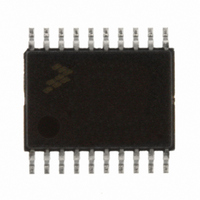MC9S08EL16CTJ Freescale Semiconductor, MC9S08EL16CTJ Datasheet - Page 209

MC9S08EL16CTJ
Manufacturer Part Number
MC9S08EL16CTJ
Description
MCU 16KB FLASH SLIC 20TSSOP
Manufacturer
Freescale Semiconductor
Series
HCS08r
Datasheet
1.DEMO9S08EL32.pdf
(356 pages)
Specifications of MC9S08EL16CTJ
Core Processor
HCS08
Core Size
8-Bit
Speed
40MHz
Connectivity
I²C, LIN, SCI, SPI
Peripherals
LVD, POR, PWM, WDT
Number Of I /o
16
Program Memory Size
16KB (16K x 8)
Program Memory Type
FLASH
Eeprom Size
512 x 8
Ram Size
1K x 8
Voltage - Supply (vcc/vdd)
2.7 V ~ 5.5 V
Data Converters
A/D 12x10b
Oscillator Type
External
Operating Temperature
-40°C ~ 85°C
Package / Case
20-TSSOP
Processor Series
S08EL
Core
HCS08
Data Bus Width
8 bit
Data Ram Size
1 KB
Interface Type
SCI, SPI, I2C, SLIC
Maximum Clock Frequency
200 KHz
Number Of Programmable I/os
16
Number Of Timers
2
Operating Supply Voltage
5.5 V
Maximum Operating Temperature
+ 85 C
Mounting Style
SMD/SMT
3rd Party Development Tools
EWS08
Development Tools By Supplier
DEMO9S08EL32AUTO, DEMO9S08EL32
Minimum Operating Temperature
- 40 C
On-chip Adc
10 bit, 12 Channel
For Use With
DEMO9S08EL32 - BOARD DEMO FOR 9S08 EL MCUDEMO9S08EL32AUTO - DEMO BOARD EL32 AUTO
Lead Free Status / RoHS Status
Lead free / RoHS Compliant
- Current page: 209 of 356
- Download datasheet (9Mb)
For clarification, in this document, “command” messages will refer to any message frame where the SLIC
module is receiving data bytes and “request” messages refer to message frames where the SLIC module
will be expected to transmit data bytes. This is a generic description and should not be confused with the
terminology in the LIN specification. The LIN use of the terms “command” and “request” have the same
basic meaning, but are limited in scope to specific identifier values of 0x3C and 0x3D. In the SLIC module
documentation, these terms have been used to describe these functional types of messages, regardless of
the specific identifier value used.
12.6.7.2
Possible errors on message headers are:
12.6.8
Figure 12-15
from the master node.
Command message frames refer to LIN messages frames where the master node is “commanding” the
slave node to do something. The implication is that the slave will then be receiving data from the master
for this message frame. This can be a standard LIN message frame of 1–8 data bytes, a reserved LIN
system message (using 0x3C identifier), or an extended command message frame utilizing the reserved
0x3E user defined identifier or perhaps the 0x3F LIN reserved extended identifier. The SLIC module is
capable of handling message frames containing up to 64 bytes of data, while still automatically calculating
and/or verifying the checksum.
12.6.8.1
After the application software has read the incoming identifier and determined that it is a valid identifier
which cannot be ignored using IMSG, it must determine if this message frame is a command message
frame or a request message frame. (i.e., should the application receive data from the master or send data
back to the master?)
The first case, shown in
data from the master node. If the received identifier corresponds to a standard LIN command frame (i.e.,
1–8 data bytes), the user must then write the number of bytes (determined by the system designer and
directly linked with this particular identifier) corresponding to the length of the message frame into
SLCDLC. The two most significant bits of this register are used for special control bits describing the
nature of this message frame.
Freescale Semiconductor
•
•
Identifier-Parity-Error
Byte Framing Error
Handling Command Message Frames
Possible Errors on Message Headers
Standard Command Message Frames
shows how to handle command message frames, where the SLIC module is receiving data
MC9S08EL32 Series and MC9S08SL16 Series Data Sheet, Rev. 3
Figure 12-15
deals with command messages, where the SLIC will be receiving
211
Related parts for MC9S08EL16CTJ
Image
Part Number
Description
Manufacturer
Datasheet
Request
R
Part Number:
Description:
Manufacturer:
Freescale Semiconductor, Inc
Datasheet:
Part Number:
Description:
Manufacturer:
Freescale Semiconductor, Inc
Datasheet:
Part Number:
Description:
Manufacturer:
Freescale Semiconductor, Inc
Datasheet:
Part Number:
Description:
Manufacturer:
Freescale Semiconductor, Inc
Datasheet:
Part Number:
Description:
Manufacturer:
Freescale Semiconductor, Inc
Datasheet:
Part Number:
Description:
Manufacturer:
Freescale Semiconductor, Inc
Datasheet:
Part Number:
Description:
Manufacturer:
Freescale Semiconductor, Inc
Datasheet:
Part Number:
Description:
Manufacturer:
Freescale Semiconductor, Inc
Datasheet:
Part Number:
Description:
Manufacturer:
Freescale Semiconductor, Inc
Datasheet:
Part Number:
Description:
Manufacturer:
Freescale Semiconductor, Inc
Datasheet:
Part Number:
Description:
Manufacturer:
Freescale Semiconductor, Inc
Datasheet:
Part Number:
Description:
Manufacturer:
Freescale Semiconductor, Inc
Datasheet:
Part Number:
Description:
Manufacturer:
Freescale Semiconductor, Inc
Datasheet:
Part Number:
Description:
Manufacturer:
Freescale Semiconductor, Inc
Datasheet:
Part Number:
Description:
Manufacturer:
Freescale Semiconductor, Inc
Datasheet:










